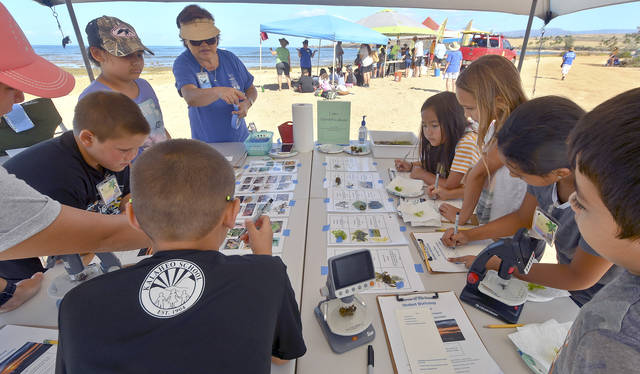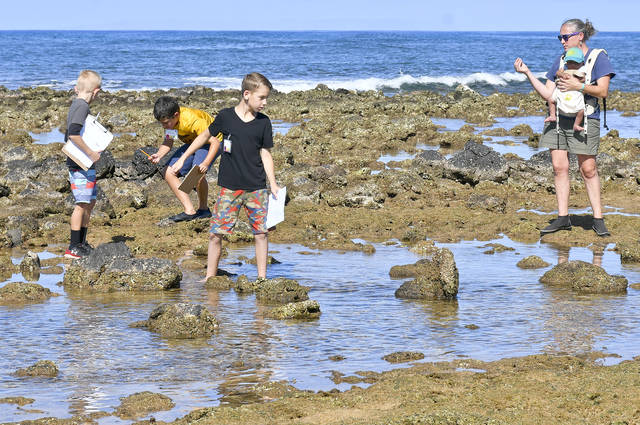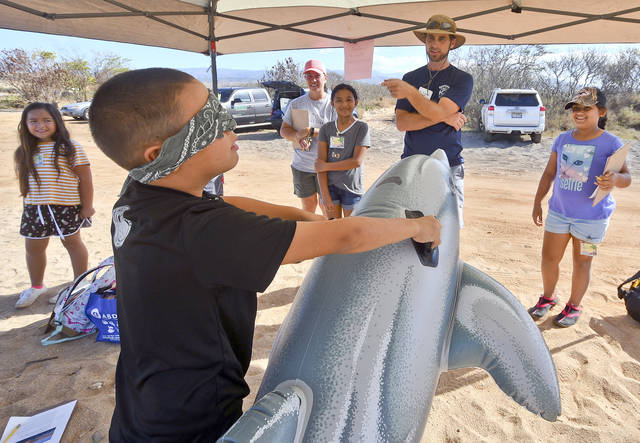HANAPEPE — There was a goat on Salt Pond Beach on Friday, but it was a little smaller than the average ungulate on Kauai.
The forest it was standing in was smaller than the average, too.
“We’re building a forest over here,” said Ray Kahaunaele to the group of Kalaheo School third-graders that were gathered under the Kauai Invasive Species Council tent on the beach.
On display were two containers filled with dirt. In one, kids placed native plants and moss until the entirety of the soil was covered. In the other, they placed a few invasive plants and the plastic goat — that symbolized the hooved animals that impact the ecosystems on Kauai.
“What do you think is going to happen when the rain comes?” Kahaunaele asked as he poured water over both of the containers.
“It’s gunna come out everywhere,” third-grade student Kyla Malama answered, pointing to the container with the invasive species and watching KISC volunteers perform the experiment.
Sure enough, she was right. The container with the native plants retained most of the water while that with the invasives drained out quickly.
Classmate Jack Schmidt pointed out the plants were the things keeping the water in the container and summarized the reasons for containing and eliminating invasive species in one, simple statement.
“Don’t plant a tree somewhere that can spread everywhere,” he said.
Meanwhile, outside a tent next door, Kalaheo students played games simulating seabird movements. Farther down the line, students learned about how to make shoreline observations and about toothed whale echolocation.
The Kauai Fire Department Ocean Safety Bureau’s David Duncan manned the station dedicated to water rescues. His display was littered with flotation devices and tools for rescue — both conventional and improvised.
Students in his tent together chanted the phrase: “never endanger yourself,” the take-away message of the day from Duncan’s station.
“Everybody can learn how to help someone in trouble in the ocean,” he said.
The beach was the ideal place to do that, too.
“You learn track and field on the track and in the field,” Duncan said. “You learn ocean safety at the beach.”
Out on the reef, kids learned limu identification and took observations on the animals and process.
Stations were staffed with volunteers and staff members from the state Department of Land and Natural Resources, National Oceanic and Atmospheric Administration, Kilauea Point Natural History Association and the U.S. Fish and Wildlife Service.
And overseeing it all were Kalaheo School teacher Annalisa Rivera and Jean Souza with the NOAA Office of National Marine Sanctuaries, Pacific Islands Region.
“This is a different way to do it (teach ocean science at the beach),” Souza said, pointing out the kids were simply watching and taking notes out on the reef, not catching anything. “We’re observing, not disturbing.”
Instead of allowing students to overturn every rock and pick up every sea cucumber, Kalaheo School partnered with Souza and her team of volunteers from various agencies to learn about the place of Salt Pond Beach Park while also preserving it.
And all of the lessons taught during the session adhere to the state Department of Education’s teaching objectives.
“There’s a lot we can do to learn and continue to protect and preserve (the environment),” Rivera said.
•••
Jessica Else, environment reporter, can be reached at 245-0452 or jelse@thegardenisland.com.






